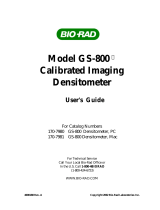
DTP32HS DENSITOMETER
1
CE Declaration
Manufacturer's Name: X-Rite, Incorporated
Manufacturer's Address: 3100 44
th
Street, S.W. • Grandville, Michigan • U.S.A.
Model Name: Densitometer
Model No.: DTP32HS
Directive(s) Conformance: EMC 89/336/EEC LVD 73/23/EEC
Federal Communications Commission Notice
This equipment has been tested and found to comply with the limits for a Class B digital device,
pursuant to Part 15 of the FCC Rules. These limits are designed to provide reasonable protection
against harmful interference in a residential installation. This equipment generates, uses, and can
radiate radio frequency energy and, if not installed and used in accordance with the instructions,
may cause harmful interference with radio communications. However, there is no guarantee that
interference will not occur in a particular installation. If this equipment does cause harmful
interference to radio or television reception, which can be determined by turning the equipment off
and on, the user is encouraged to try to correct the interference by one or more of the following
measures: reorient or relocate the receiving antenna; increase the separation between the
equipment and receiver; connect the equipment into an outlet on a circuit different from that to
which the receiver is connected; and/or consult the dealer or an experienced radio/television
technician for help.
NOTE: Shielded interface cables must be used in order to maintain compliance with the desired
FCC and European emission requirements.
Industry Canada Compliance Statement
This Class B digital apparatus meets all requirements of the Canadian Interference-Causing
Equipment Regulations.
Cet appareil numérique de la classe B respecte toutes les exigences du Règlement sur le matériel
brouilleur du Canada.
Equipment Information
Use of this equipment in a manner other than that specified by X-Rite, Incorporated may
compromise design integrity and become unsafe.
WARNING: This instrument is not for use in explosive environments.
ADVERTENCIA - NO use este aparato en los ambientes explosivos.
AVVERTIMENTO - NON usare questo apparecchio in ambienti esplosivi.
WARNUNG: Das Gerät darf in einer explosiven Umgebung NICHT verwendet werden.
AVERTISSEMENT: Cet instrument ne doit pas être utilisé dans un environnement explosif.
Proprietary Notice
The information contained in this manual is derived from patent and proprietary data of
X-Rite, Incorporated. The contents of this manual are the property of X-Rite, Incorporated and are
copyrighted. Any reproduction in whole or part is strictly prohibited. Publication of this information does
not imply any rights to reproduce or use this manual for any purpose other than installing, operating, or
maintaining this instrument. No part of this manual may be reproduced, transcribed, transmitted, stored
in a retrieval system, or translated into any language or computer language, in any form or by any means,
electronic, magnetic, mechanical, optical, manual, or otherwise, without the prior written permission of an
officer of X-Rite, Incorporated.
This product may be covered by one or more patents. Refer to the instrument for actual patent numbers.
Copyright © 2003 by X-Rite, Incorporated “ALL RIGHTS RESERVED”
X-Rite® is a registered trademark of X-Rite, Incorporated. All other logos, brand names, and product names mentioned are the
properties of their respective holders.





















